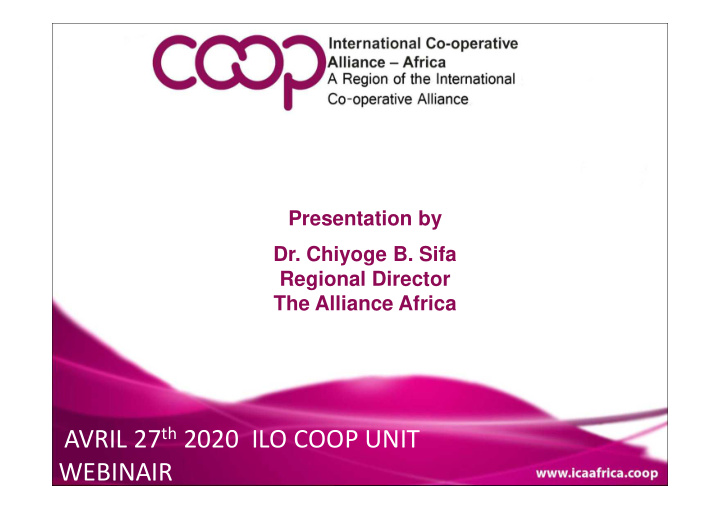



Presentation by Dr. Chiyoge B. Sifa Regional Director The Alliance Africa AVRIL 27 th 2020 ILO COOP UNIT WEBINAIR
Outline • Introduction • Women in Africa • Women in Coops • Challenges and way forward
Introduction
Introd….Contd • Gender inequality remains one of the greatest barriers to human development. The average HDI for women is 6 percent lower than that of men. • Since the first World Conference on Women in Mexico City, women are still at the same place they were. That is, trying to sensitize the world to the unwarranted and unacceptable marginalization of women, which deprives them of their human rights • In Africa, fifty years after the end of colonialism, the question is: To what extent has the promise of that call been realized for African women? When the African Union declared the period between 2010 and 2020 as the African Women’s Decade, many leaders recognized that progress on gender equality and women’s empowerment in Africa has been much too slow. • On average, women in SSA achieve 87 percent of male human development outcomes, due to fewer viable economic opportunities, a lower quality of health, and lower education attainment. This impedes economic and social development in the region. • According to the United Nations, gender inequality costs SSA an average of $US95 billion a year. • By eliminating gender inequality and empowering women, it’s possible to raise the productive potential of one billion Africans and boost the continent’s development potential.
Intro-----Contd.. • Global labor force participation rates for women are at 49 percent, compared to 75 percent for men. • Women also do far more unpaid domestic work than their male counterparts. Overall, the HDI for women lags 6 percent behind that of men • Looking at the widening gap in real terms, a child born in Norway today – the country with the highest human development index (HDI) – can expect to live beyond the age of 82, and spend almost 18 years in school. But the same child, if born in Niger – the lowest HDI – can expect only to live to 60, with just five years of formal education.
HDI-1990-2017 Source: Human Development Indices and Indicators: 2018 Statistical Update
Trends in the Gender Inequality Index (2000 – 2015)
Women in Africa • Women’s formal ownership of SMEs currently stands at around 1/3 of all registered SMEs in Africa. • Women are seen as entrepreneurs of necessity, rather than opportunity • African women have been called “a powerful untapped economic force” and will be absolutely integral in addressing the development challenges Africa faces. • Currently, African women constitute the majority of workers in the informal economy, and only about 1/3 across the continent participate in formal economic activity.
Women’s representation in Leadership Position
Women’s representation on the boards of African companies by region
Women Representation in management
Women in Co-operatives • Address inequalities-- Achieve gender equality • Access to resources and markets • Strong link between women in co-operatives and poverty reduction • Women participate more in Productive activities- Benefit community • Cooperatives are a readily available solution to poverty question already at village level • Getting women organized around their work empowers them not only to deal with issues around their work but also issues around their HHs & society at large • Gender mainstreaming helps to address these gender gaps in development
Examples of Women in Coops: Ethiopia
Examples of Women in Coops: Namibia
Examples of Women---Contd..
Examples of Women in Coops: Morocco https://www.youtube.com/watch?v=T5wpZfVjwng
Challenges • less women in leadership positions and less women in managerial positions, • women are the majority of Co-operative members and clientele globally! • women have less access to the resources • Women have minimal say on arising incomes/ benefits. • Are present at all stages of value chain except and decision making of benefits • Some bye-laws discriminate women’s participation or ascendancy to leadership positions e.g capping on Kgs of coffee required for leaders • Some conditions in which deliberations take place keep women away e.g violence at AGMS, choice of venue for leadership meetings etc
Way forward
• Education, education and again education.
The Alliance Africa @ICA_AFRICA1 www.icaafrica.coop
Recommend
More recommend